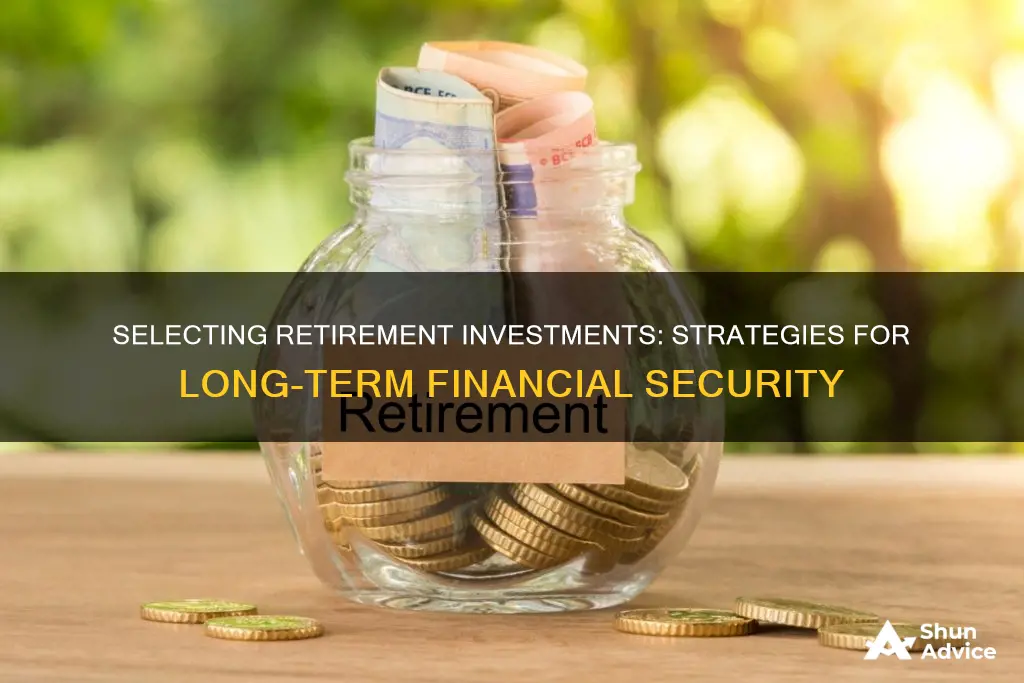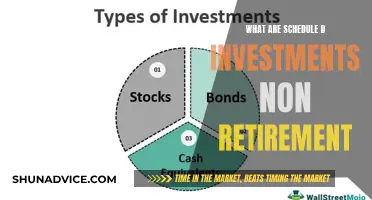
Choosing the right investments for your retirement is critical to getting the most out of your savings. Here are some key factors to consider when selecting investments for your retirement portfolio:
- Diversification: Diversification is a risk management strategy that involves spreading your investments across different asset classes, sectors, and geographic regions. By diversifying your portfolio, you reduce the impact of losses in any one investment and increase your potential for overall returns.
- Risk Tolerance: Consider your risk tolerance, which is your ability to withstand volatility and potential losses in your investments. Younger investors may have a higher risk tolerance and can invest more aggressively, while older investors may prefer more conservative investments to preserve their capital.
- Time Horizon: Your investment time horizon is the number of years you have until retirement. If you have a longer time horizon, you can afford to take on more risk and invest in growth-oriented assets. As you get closer to retirement, you may want to adjust your portfolio to more conservative investments to protect your savings.
- Fees and Expenses: Investment fees and expenses can eat into your returns over time. Pay attention to expense ratios and other fees associated with the investments you choose. Lower-cost investments, such as index funds and ETFs, can help maximize your returns.
- Tax Advantages: Take advantage of tax-advantaged retirement accounts, such as 401(k)s and IRAs, which offer tax breaks that can boost your savings. Consider the tax implications of different investment options to make the most tax-efficient choices.
- Employer Matching: If your employer offers a 401(k) match, contribute at least enough to get the full match. This is essentially free money and can significantly boost your retirement savings over time.
- Asset Allocation: Determine an appropriate asset allocation between stocks and bonds based on your risk tolerance and investment goals. Stocks typically offer higher potential returns but come with higher risk, while bonds are considered safer but tend to provide lower returns.
- Investment Research: Conduct thorough research before selecting specific investments. Consider factors such as historical performance, fees, diversification, and the companies or sectors included in the investment fund.
- Professional Guidance: If you need help, consider seeking advice from a financial advisor or a robo-advisor, which uses computer algorithms to provide investment recommendations. They can help you make informed decisions and create a personalized retirement plan.
| Characteristics | Values |
|---|---|
| Cost | Low-cost investments help you keep as much as possible for your retirement. |
| Diversification | Spread out your risk by investing in a variety of securities. |
| Trading flexibility | ETFs can be bought and sold at any point during the trading day. |
| Management | Mutual funds are professionally managed. |
| Accessibility | You can withdraw money from a 401(k) from 59 1/2 without penalty. |
| Tax advantages | 401(k)s and IRAs are tax-deferred accounts. |
| Matching contributions | Some employers offer matching contributions. |
What You'll Learn

Understand your retirement account options
Understanding your retirement account options is a critical step in planning for retirement. There are various types of accounts to choose from, each with its own set of features and benefits. Here are some of the most common retirement account options:
Employer-Sponsored Plans:
- 401(k): One of the most popular retirement plans offered by employers. It allows employees to contribute pre-tax wages, which grow tax-free until retirement. The employee contribution limit for 2024 is $23,000, or $30,500 for those aged 50 and over. A Roth 401(k) option is also available, where contributions are made with after-tax dollars, and withdrawals in retirement are tax-free.
- 403(b) and 457(b): Similar to 401(k) plans, these are offered by public schools, charities, and government employers. They have similar tax advantages and contribution limits.
Individual Retirement Accounts (IRAs):
- Traditional IRA: This is a tax-advantaged plan where contributions are made with pre-tax dollars, and taxes are paid upon withdrawal in retirement. The contribution limit for 2024 is $7,000, or $8,000 for those aged 50 and over.
- Roth IRA: Contributions are made with after-tax dollars, and withdrawals in retirement are tax-free. There are no required minimum distributions. The contribution limits are the same as for traditional IRAs.
- Spousal IRA: Allows the spouse of a worker with earned income to contribute to an IRA, even if they don't have their own income.
- Rollover IRA: Created when moving funds from a 401(k) or another retirement account to a new IRA. It allows you to continue taking advantage of tax benefits.
- SEP IRA: Similar to a traditional IRA but designed for self-employed individuals and small business owners. The contribution limit for 2024 is 25% of compensation or $69,000, whichever is less.
- SIMPLE IRA: Similar to a 401(k) plan but with simplified administration and lower contribution limits. It is often used by small businesses.
- Solo 401(k): Designed for business owners and their spouses, allowing higher contribution limits and profit-sharing options.
Defined Benefit Plans:
- Traditional Pensions: Fully funded by employers, providing a fixed monthly benefit based on salary history and duration of employment. However, these plans are becoming less common.
- Cash-Balance Plans: A type of defined benefit plan that promises a hypothetical account balance based on contribution and investment credits. It provides more certainty about the benefit amount but is still portable if you change jobs.
Annuities:
Guaranteed Income Annuities (GIAs): Individuals can purchase these annuities to create their own pension-like income stream in retirement. They can be bought on a tax-deferred basis or within an IRA.
Government Plans:
Federal Thrift Savings Plan (TSP): Available to government workers and members of the uniformed services, offering low-cost investment options and employer contribution matching.
When choosing a retirement account, it's important to consider factors such as tax advantages, contribution limits, portability, investment options, and whether your employer offers matching contributions. It's also essential to start saving and investing early to take advantage of compound interest and give your investments more time to grow.
Young Investors: Who and How Many?
You may want to see also

Start saving and investing early
When it comes to retirement planning, it's never too early to start. The earlier you begin, the less money you'll need to put away each year, and the more time your savings will have to grow. Here are some reasons why starting early is beneficial:
Compound Interest
Compound interest is often described as the most significant benefit of investing early for retirement. When you start saving earlier, you'll end up with more money, even with a smaller capital investment, compared to starting later in your career. This is because compound interest is the process of a sum of money growing exponentially due to interest building upon itself over time. The longer your investment horizon, the more time your money has to grow.
For example, if you invest $1,000 in a safe long-term bond that earns 3% interest per year, you'll have $1,030 at the end of the first year. In the second year, you'll earn 3% interest on the new total of $1,030, resulting in $30.90 of interest for that year. This process continues, and the growth becomes more pronounced over time.
Financial Flexibility
The longer you wait to save for retirement, the larger the amount you'll need to set aside from your paycheck to achieve your retirement goals. Starting early allows you to set aside a smaller amount each month, providing more financial flexibility in managing your daily expenses.
Access to Higher-Risk, Higher-Reward Investments
Starting your retirement investments early grants you access to a more diversified portfolio. You'll have the time to tap into higher-risk, higher-reward investments, which can give you a more substantial financial cushion when you retire. Additionally, starting early increases the likelihood of your investments successfully weathering market fluctuations.
Inflation
People who start saving for retirement earlier in their careers increase the chances of their savings keeping pace with inflation. Inflation erodes the purchasing power of your money over time, so starting early helps ensure that your savings retain their value.
Longer Life Expectancies
With advancements in medicine and technology, people are living longer than ever before. This means that you'll likely need more money to retire and care for yourself when you're no longer working. Healthcare costs also tend to increase as you grow older, so it's essential to prepare by getting an early start on your retirement savings.
Social Security: Opting In or Out?
You may want to see also

Calculate your net worth
When it comes to retirement planning, it's essential to make informed decisions about your investments. Here's a guide to help you choose wisely:
Understanding your net worth is crucial for making prudent investment decisions. Here's how you can calculate it:
Step 1: Identify Your Assets
Assets are valuable possessions that you own. These include:
- Cash: Money in your bank accounts, such as checking, savings, and retirement accounts.
- Investments: The market value of your investment portfolio, including stocks, bonds, and mutual funds.
- Real Estate: The current market value of any properties you own, such as your primary residence or investment properties.
- Vehicles: The market value of your cars, boats, or other vehicles.
- Other Valuable Possessions: Any other items of significant value that you could sell for cash, such as jewellery, collectibles, or artwork.
Step 2: Calculate Your Liabilities
Liabilities are essentially your financial debts and obligations. These include:
- Credit Card Debt: Any outstanding balances on your credit cards.
- Loans: Student loans, mortgages, auto loans, personal loans, or any other type of loan you have taken out.
- Accounts Payable: Money that you owe to suppliers or vendors.
- Bills and Taxes: Any unpaid utility bills, tax liabilities, or other financial obligations.
Step 3: Calculate Your Net Worth
Now, you can calculate your net worth using the following formula:
Net Worth = Total Assets – Total Liabilities
For example, let's say your assets include $100,000 in savings, a house worth $200,000, a car worth $25,000, and an investment portfolio worth $50,000. Your liabilities include a mortgage of $120,000, a car loan of $15,000, credit card debt of $5,000, and taxes payable of $10,000. Your net worth would be:
Net Worth = ($100,000 + $200,000 + $25,000 + $50,000) – ($120,000 + $15,000 + $5,000 + $10,000)
Net Worth = $375,000 – $150,000 = $225,000
So, in this example, your net worth would be $225,000. This calculation provides a snapshot of your financial position and can help guide your investment choices for retirement.
Tips for Improving Your Net Worth:
- Reduce Liabilities: Focus on paying off your debts and liabilities. This can include creating a budget, using debt reduction strategies, or negotiating with creditors.
- Increase Assets: Look for opportunities to increase your assets, such as investing in appreciating assets or diversifying your investment portfolio.
- Regularly Review Your Net Worth: Calculate your net worth periodically to track your financial progress and make necessary adjustments to your investment strategies.
Vegetable Gardens: Healthy, Wealthy, Happy
You may want to see also

Keep your emotions in check
Emotions can often get in the way of making good financial decisions. Emotional investing can lead to overconfidence, underestimating risks, and making bad decisions that lose money. It is important to be mindful of your wins and losses and take time to evaluate your choices and learn from your mistakes.
Be Realistic
Not every investment will be a winner, and not every stock will grow. It is important to be realistic and accept that there will be ups and downs.
Have a Plan and Stick to It
Having a plan is key to any investment strategy. Setting investment goals will help determine how much risk you are willing to take and inform your decisions when building a portfolio. Before making any investment, decide how much risk you are comfortable with. When you have a solid plan, a setback is less likely to cause panic. Discipline is important to stick to your plan and avoid making impulsive decisions.
Diversify Your Portfolio
Diversification is a crucial tool for any investor. It helps to avoid getting emotional about your investments as a well-balanced and diverse portfolio is less affected by market swings. Diversifying your investments can be done within and across asset classes and geographies, investing in both developed and emerging markets. This will give you peace of mind and help you avoid making snap judgments or hasty decisions due to loss aversion.
Focus on Long-Term Emotions
Short-term emotions like fear and greed can negatively impact investment decisions. Instead, focus on the bigger emotional picture of the stage of life you are in. As you get closer to retirement, you may want to shift your portfolio towards lower-risk/lower-reward investments.
Surround Yourself with Wise People
Consider seeking advice from a financial advisor or surrounding yourself with wise people who can offer a counterbalance to your knee-jerk emotions. These people can help you make decisions that are in your best interest and consider your long-term emotions and goals.
Retirement Investing: Why You Shouldn't Bother
You may want to see also

Pay attention to investment fees
When it comes to choosing investments for your retirement, fees are an important factor to consider. Investment fees are charged for the use of financial products and services, and they can have a significant impact on your overall returns. Over time, minimising fees tends to maximise performance, so it's crucial to be mindful of them when making investment decisions. Here are some key points to keep in mind:
- Understand Common Fees: Investment fees can include brokerage fees, trading fees, expense ratios, advisory fees, commissions, loads, and account or custodian fees. These fees vary based on the type of investment and the financial institution.
- Impact on Returns: Fees might seem low at first glance, but they can significantly reduce your overall returns over time. Even a small percentage fee can result in substantial reductions in your retirement savings. It's important to understand how these fees impact your net returns.
- Compare Fees: Different investments and financial institutions may charge varying fees for similar services. It's essential to compare fees before making a decision. Look for investments with low expense ratios and be cautious of funds with front-end or back-end load charges, as these can eat into your returns.
- Consider Low-Fee Options: Some investments inherently carry lower fees. Indexed products like ETFs (exchange-traded funds) and index mutual funds often offer relatively low fees, making them attractive to cost-conscious investors. Additionally, consider no-fee brokers and low-cost index funds to minimise fees.
- Don't Sacrifice Performance: While minimising fees is important, don't let it be the sole deciding factor. It's a balance between keeping fees low and ensuring you're getting a good deal. Some higher-cost funds may offer stronger performance, but evaluate whether the extra cost is justified by their returns.
- Long-Term Impact: The impact of fees compounds over time, especially for long-term investments like retirement accounts. Younger investors starting out are more vulnerable to the effects of high fees, as the total dollars lost to costs will grow exponentially over their investment horizon.
- Get Professional Help: If you're unsure about investment fees or need help navigating the options, consider seeking advice from a financial advisor or a robo-advisor. They can provide guidance and help you make informed decisions about your retirement investments.
Remember, investment fees are an essential aspect of your overall investment strategy. By understanding the types of fees, comparing options, and making informed choices, you can maximise your returns and work towards a more secure retirement.
Target: Invest Now or Miss Out?
You may want to see also
Frequently asked questions
There are several types of retirement accounts, including 401(k)s, 403(b)s, 457(b)s, IRAs (traditional, Roth, spousal, rollover, SEP, SIMPLE), defined benefit plans (pensions), guaranteed income annuities (GIAs), and cash-value life insurance plans.
Common investments for retirement include mutual funds, index funds, exchange-traded funds (ETFs), stocks, bonds, certificates of deposit (CDs), and cash-value life insurance plans.
Financial experts generally recommend contributing between 10% to 15% of your income to your retirement account, especially when you are young, as this will take advantage of compound interest. It's also important to contribute at least enough to get your employer's match, if they offer one.
To determine your risk tolerance, you should consider your age, investment horizon, and appetite for risk. A common formula for determining your asset allocation is 110 minus your age, which gives you the percentage of your portfolio that should be invested in stocks (equities), with the rest in bonds.
When choosing specific investments, it's important to do your research. Consider factors such as fees, performance over time, holdings, and allocation. You can use resources like Morningstar to research different investment options. Diversification is also important to reduce risk.







